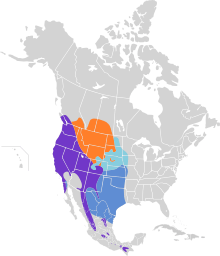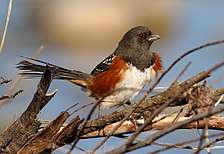Spotted towhee
The spotted towhee (Pipilo maculatus) is a large New World sparrow. The taxonomy of the towhees has been debated in recent decades, and until 1995 this bird and the eastern towhee were considered a single species, the rufous-sided towhee. Literature before 1995 referred to the spotted towhee as a rufous-sided towhee that resides in the western United States.[2] An archaic name for the spotted towhee is the Oregon towhee (Pipilo maculatus oregonus). The call may be harsher and more varied than for the eastern towhee.
| Spotted towhee | |
|---|---|
 | |
| Scientific classification | |
| Kingdom: | Animalia |
| Phylum: | Chordata |
| Class: | Aves |
| Order: | Passeriformes |
| Family: | Passerellidae |
| Genus: | Pipilo |
| Species: | P. maculatus |
| Binomial name | |
| Pipilo maculatus Swainson, 1827 | |
 | |
The form that breeds on Socorro Island is much smaller than other rufous-sided towhees, and has gray upperparts. It is sometimes split as the Socorro towhee (Pipilo socorroensis).
Description

The spotted towhee is a large New World sparrow, roughly the same size as a Robin. It has a long, dark fan shaped tail with white corners on the end. They have a round body (similar to New World sparrows) with bright red eyes and dull pink legs. The spotted towhee is between 17 cm (6.7 in) and 21 cm (8.3 in) long, and weighs in at between 33 g (1.2 oz) and 49 g (1.7 oz).[3]
Adult males have a generally darker head, upper body and tail with a white belly, rufous sides, white spots on their back and white wing bars. Females look similar but are dark brown and grey instead of black. The spotted towhee has white spots on its primary and secondary feathers; the Eastern towhee is the same bird in terms of its size and structure but does not have white spots.[3]
Distribution and habitat
The spotted towhee lives in dry upland forests[4] and breeds across north-western North America. It is present in California, Nevada, Arizona, Utah, Oregon, Washington, and southern British Columbia[5] year round. It is not found in arid climates and as a result does not reside in the Sonoran Desert, but resides in northern Arizona and the entirety of California except the southeast corner that borders Arizona. It has also been known to expand as far eastward as western Iowa and southwestern Minnesota. They also occur in fringe wetland forests and riparian forests near the border of upland forests.[4] Because spotted towhees' habitat overlaps with areas of the United States that experience regular forest fires (Arizona, New Mexico, California), they tend to be found in unburned chaparral and avoid chaparral and forests which have been burned[6][7] due to lack of ground cover and minimal foraging ability. Spotted towhees will be present in an area that is recovering after a burn (less than 15 years old),[8] due to excellent ground cover and ease of ground foraging from the recovering understory vegetation,[6] although populations will decrease after a forest fire until the vegetation has grown back.[9]
Its breeding habitat in the southwest is largely dependent on Coastal sage scrub, as it provides cover from predators.[10] They migrate to northern and northwestern United States and southwestern Canada to breed in scrubland, parks and suburban gardens.[5] On the coast, it is much more common in the Coastal Douglas-fir present in Wyoming, Montana Idaho and British Columbia. Northwestern birds migrate eastwards to the central plains of the United States, mostly the northwestern-central Great Plains. In other areas, some birds may move to lower elevations in the winter. Their breeding habitat is chaparral, thickets or shrubby areas across western North America. This bird interbreeds with the collared towhee where their ranges overlap in southwestern Mexico.
Behavior
Breeding and nesting

They nest either on the ground or low in bushes, seldom more than 1.5 m (4.9 ft) above the ground[11] and most nests are around 40 cm (1.3 ft) above the ground.[12] The location for the nests is usually found in exposed areas, but conceal the nest as it is being built.[13] The female builds the nest over a period of about five days. It is bulky and sturdily made of leaves, strips of bark, twigs, forb stalks, and grasses, lined with pine needles, shredded bark, grass, and sometimes hair. It is usually 4.5 in (11 cm) in diameter with an inner ring of 2.5 in (6.4 cm) to 4 in (10 cm). The nests are built so the rim is at ground level and the nest is 2.5 in (6.4 cm) deep.
At least two broods, consisting of three to five eggs, are laid per season. The egg shells are grayish or creamy-white, sometimes with a tinge of green, with reddish brown spots that can form a wreath or cap. The eggs are slightly oblong, with their dimensions being 2 cm (0.79 in) to 2.6 cm (1.0 in) long and 1.7 cm (0.67 in) to 1.9 cm (0.75 in) wide. The female incubates the eggs alone for 12 to 14 days; the young leave the nest at 10 to 12 days. Nests are parasitized by cowbirds.
Diet
These birds forage on the ground or in low vegetation,[2][13] with a habit of noisily rummaging through dry leaves searching for food. During the breeding season (spring and summer) they mainly eat insects, ground dwelling beetles, spiders and other arthropods that reside in the leaf litter that is foraged by the spotted towhee. They only eat protein rich food in the breeding season, and in the fall and winter they focus on foraging for acorns, seeds oats and berries.[13] They will frequent bird feeders if present in their woodland habitat.
Threats
Their main predators in less developed areas are ground dwelling snakes because nests are built on the ground. There is a strong relationship between the number of snakes that a nest encounters and the lowered probability of young chicks fledgling.[10] In developed areas and habitat near urban development their main predators are household cats.[13]
References
- BirdLife International (2012). "Pipilo maculatus". IUCN Red List of Threatened Species. 2012. Retrieved 26 November 2013.CS1 maint: ref=harv (link)
- Davis, John. (1957). "Comparative Foraging Behavior of the Spotted and Brown Towhees" (PDF). The Auk. 74 (2): 129–166. doi:10.2307/4081708.
- "Spotted towhee Identification". Cornell Lab of Ornithology.
- Lehmkuhl, John F.; E. Dorsey Burger (2007). "Breeding Birds in Riparian and Upland Dry Forests of the Cascade Range" (PDF). The Journal of Wildlife Management. 71 (8): 2632–2643. doi:10.2193/2007-004. JSTOR 4496384.
- Ryder, J M. "Spotted Towhee". The Atlas of the Breeding Birds of British Columbia, 2008-2012. Retrieved 12 May 2019.
- KATHRYN L. PURCELL; SCOTT L. STEPHENS (2005). "CHANGING FIRE REGIMES AND THE AVIFAUNA OF CALIFORNIA OAK WOODLANDS" (PDF). Studies in Avian Biology (30): 33–45.
- CARL E. BOCK; WILLIAM M. BLOCK (2005). "Variation in Top-Down Control of Avian Reproductive Success across a Fragmentation Gradient" (PDF). Studies in Avian Biology (30): 14–32.
- Kirkpatrick, Chris; Courtney J. Conway (2006). "Distribution and Relative Abundance of Forest Birds in Relation to Burn Severity in Southeastern Arizona" (PDF). The Journal of Wildlife Management. 70 (4): 1005–1012. doi:10.2193/0022-541x(2006)70[1005:daraof]2.0.co;2.
- BAGNE, KAREN E.; KATHRYN L. PURCELL. (2011). "Short-Term Responses of Birds to Prescribed Fire in Fire-Suppressed Forests of California" (PDF). The Journal of Wildlife Management. 75 (5): 1051–1060. doi:10.1002/jwmg.128.
- Patten, Michael A.; Douglas T. Bolger (2003). "Variation in Top-Down Control of Avian Reproductive Success across a Fragmentation Gradient" (PDF). Oikos. 101 (3): 479–488. doi:10.1034/j.1600-0706.2003.12515.x. JSTOR 3547774.
- "Spotted Towhee Pipilo maculatus" (PDF). San Diego Natural History Museum. Retrieved 16 April 2019.
- Small, Stacy L.; Frank R. Thompson (2007). "Spotted Towhee Population Dynamics in a Riparian Restoration Context" (PDF). The Condor. 109 (4): 721–733. doi:10.1093/condor/109.4.721. JSTOR 40072320.
- "Spotted towhee Life History". Cornell Lab or Ornithology.
External links
| Wikimedia Commons has media related to the spotted towhee. |
| Wikispecies has information related to Pipilo maculatus |
- Spotted towhee species account - Cornell Lab of Ornithology
- Spotted towhee - Pipilo maculatus - USGS Patuxent Bird Identification InfoCenter
- "Spotted towhee media". Internet Bird Collection.
- Spotted towhee photo gallery at VIREO (Drexel University)
- Interactive range map of Pipilo maculatus at IUCN Red List maps
